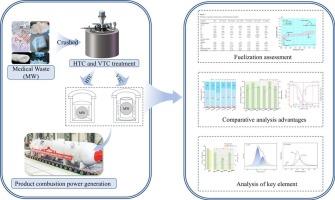医疗废物衍生燃料的能量回收和关键元件固定化:水热与蒸汽热碳化
IF 7.5
1区 工程技术
Q2 ENERGY & FUELS
引用次数: 0
摘要
针对医疗废弃物产生量快速增长和燃料利用率不足的现状,本研究对比分析了水热炭化(HTC)和蒸汽热炭化(VTC)两种反应途径,考察了燃料特性、燃烧行为以及固体产物(高碳燃料)中关键元素分布的差异。结果表明,VTC工艺能均匀化微波,提高微波质量。相比之下,HTC工艺具有更强的碳化能力,可将MW转化为高性能固体燃料。HTC产品具有更高的能量密度和碳含量(78.9%)。另一方面,在温度低于280℃时,VTC工艺在脱挥发和固定碳保留方面表现出更好的性能。SEM分析表明,VTC产品在较低温度下具有更高的表面粗糙度和更大的孔隙,表明了有效的均匀化和MW质量的提高。HTC工艺表现出优异的燃烧性能。ICP-OES和XPS结果表明,两种工艺均能有效去除MW中的钠、钾和氯,其中HTC工艺在260℃时对钠和钾的去除率最高,VTC工艺对无机氯的去除率较高,超过85%。这些研究结果为MW燃料利用提供了重要参考,并为工业应用提供了有价值的见解。本文章由计算机程序翻译,如有差异,请以英文原文为准。

Energy recovery and critical element immobilization in medical waste-derived fuel: hydrothermal vs. vapor thermal carbonization
In response to the rapidly increasing production of medical waste (MW) and the lack of fuel utilization, this study comparatively analyzes hydrothermal carbonization (HTC) and vapor thermal carbonization (VTC) as reaction pathways, examining the differences in fuel characteristics, combustion behavior, and the distribution of key elements in the solid products (high-carbon fuels). The results show that the VTC process homogenizes and improves the quality of MW. In contrast, the HTC process has a stronger carbonization ability, converting MW into high-performance solid fuels. The HTC products have higher energy density and carbon content (78.9 %). The VTC process, on the other hand, shows better performance in devolatilization and fixed carbon retention at temperatures below 280 °C. SEM analysis indicates that VTC products have higher surface roughness and larger pores at lower temperatures, demonstrating effective homogenization and improvement in the quality of MW. The HTC process exhibits superior performance in combustion behavior. ICP-OES and XPS results indicate that both processes effectively remove sodium, potassium, and chlorine from MW, with HTC achieving the highest removal rates for sodium and potassium at 260 °C and VTC achieving a higher proportion of inorganic chlorine, exceeding 85 %. These findings provide important references for the fuel utilization of MW and valuable insights for industrial applications.
求助全文
通过发布文献求助,成功后即可免费获取论文全文。
去求助
来源期刊

Fuel
工程技术-工程:化工
CiteScore
12.80
自引率
20.30%
发文量
3506
审稿时长
64 days
期刊介绍:
The exploration of energy sources remains a critical matter of study. For the past nine decades, fuel has consistently held the forefront in primary research efforts within the field of energy science. This area of investigation encompasses a wide range of subjects, with a particular emphasis on emerging concerns like environmental factors and pollution.
 求助内容:
求助内容: 应助结果提醒方式:
应助结果提醒方式:


